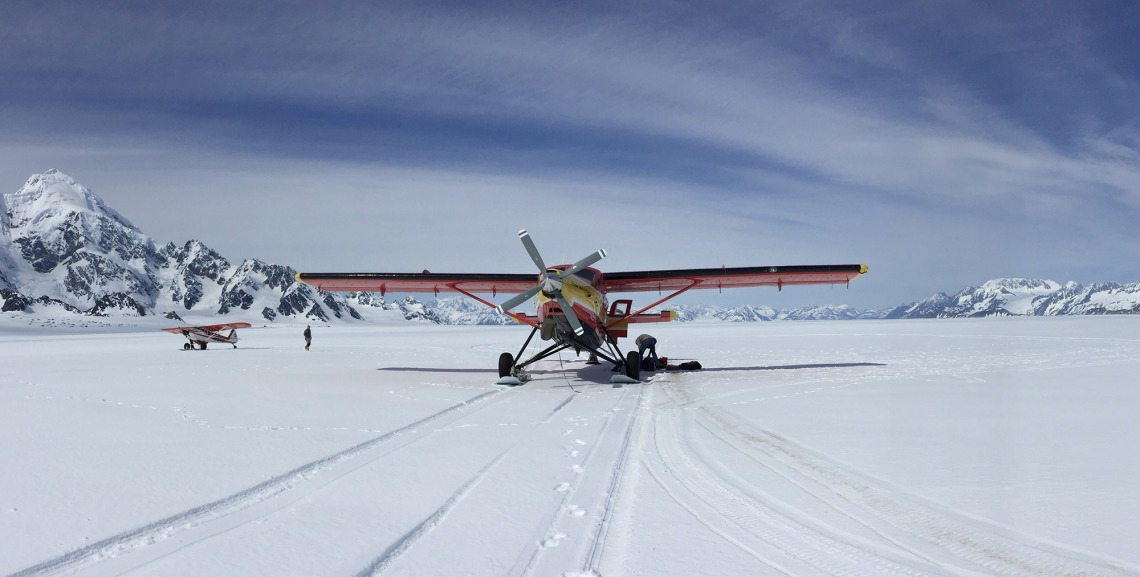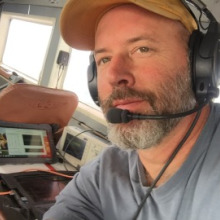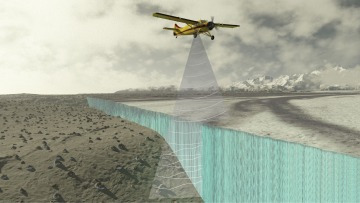Studying Arctic Glaciers with Airborne Radar: UArizona Project Attracts $30M from NASA

A University of Arizona-led project that uses advanced airborne radar mounted to low-flying aircraft to study arctic glaciers is one of six new missions that have received funding by NASA.

Dubbed Snow4Flow, the mission is led by Jack Holt, a professor in the UArizona Lunar and Planetary Laboratory and the Department of Geosciences. It is one of only two
missions, selected from 42 proposals, to be funded at $30 million. Four other projects will each receive $15 million.
The funding, announced April 19, comes from NASA's Earth Venture program, which focuses on missions that use instruments mounted on aircraft to make measurements that cannot be made from space.
Snow4Flow's goal is to get a better handle on the snowfall feeding into glaciers and how fast those glaciers move. In combination with climate models, this will allow researchers to make more accurate predictions about how glaciers shrink and grow, and how much they contribute to sea level change, Holt said.
"Those glaciers are retreating fast, and they're making a large contribution to sea level rise, but we don't know exactly how much and how that's going to change in the future," he said. "Right now, we can't accurately measure how much snow feeds into the glacier systems, and without knowing their ice thickness, you don't know the volume of ice flowing out from the glacier. Those are things that you can't measure with satellites from space."
Snow4Flow is designed to address a critical need of climate scientists in their efforts to develop accurate projections of sea level rise from the melting of land glaciers. Across four major study regions representing many hundreds of glaciers in the Northern Hemisphere – Alaska/Yukon, southeastern Greenland, the Canadian Arctic Archipelago and Svalbard archipelago in Norway – the Snow4Flow team will use microwave and long-wavelength radar sounders mounted to low-flying aircraft to measure snow accumulation and glacial ice thickness. The resulting data will inform models of glacier dynamics and their contributions to sea level rise.

The Malaspina Glacier One of Alaska's most iconic glaciers, the Malaspina Glacier spills out from the St. Elias Mountains onto the coastal plain as a "pancake of ice". Around the world, glaciers are threatened by a warming climate, and scientists need as much data as possible to refine climate prediction models. This photo was taken during a previous NASA-funded mission tasked with measuring annual changes in the thickness of glaciers, sea ice and ice sheets. - Brandon Tober/University of Arizona
While Holt's team will focus on studying glaciers in the Northern Hemisphere, the group expects the data collected over the course of the five-year project will be applicable to glaciers in other parts of the world. The measurements can be used to calibrate observations from different satellite missions, allowing scientists to monitor glaciers from space and improve models that predict how glaciers across the globe will behave and respond to climate change.
Snow4Flow centers around two instruments: one with low-frequency radar that generates the very long wavelengths needed to penetrate thick ice sheets, and another that operates at shorter wavelengths and is optimized to probe blankets of snow.
"We will mount them to small aircraft – fixed-wing, helicopters or both – which will fly low over glaciers that pass through mountain valleys," Holt said. "During those flights, we will collect data that essentially produce cross sections of the snow and glacier ice thickness."
"At the same time, these missions improve our ability to use satellites by calibrating algorithms that attempt to use spaceborne data for such purposes," he said. Airplane measuring ice thickness using radar

The Snow4Flow team will use microwave and long-wavelength radar sounders mounted to low-flying aircraft to measure snow accumulation and glacial ice thickness. - Russell Mitchell
Rather than having science and instrument teams defined at the time of the proposal, the projects selected for the NASA funding will be open to other scientists who are interested in applying to join the effort. Holt expects to have a final team assembled by fall 2025 and to begin flight operations in spring 2026. The mission will take place over three years, capturing winter snowfall before snowmelt begins in the summer months.
Holt attributes Snow4Flow's success in attracting federal funding to a strategic cluster hire at the university that included Ali Behrangi in the Department of Hydrology and Atmospheric Sciences and Chris Harig in the Department of Geosciences, through the university's Earth Dynamics Observatory. In cluster hires, multiple scholars are recruited into one or more departments based on shared research interests. Behrangi studies snowfall in high-latitude, high-altitude regions and Harig studies ice mass loss using gravity measurements from space satellites.
"The University of Arizona's continued success in attracting this level of research funding is a direct consequence of our efforts to focus our recruitment in key areas in which we offer unparalleled expertise and strength," said University of Arizona President Robert C. Robbins. "Snow4Flow is a perfect example of such an opportunity, in which our researchers will get to assemble a dream team capable of developing solutions to some of the most pressing challenges of our time."
The university's Earth Dynamics Observatory, or EDO, combines UArizona strengths in space exploration, instrumentation and Earth sciences to learn more about our planet. Collecting information about Earth from space provides new information about how Earth systems work, how they are changing and how humans might anticipate and respond to changes.
Behrangi, a professor of hydrology and atmospheric sciences, said the observatory played a crucial role in the success of the Snow4Flow proposal "by encouraging innovative thinking, allowing the team to break free from conventional ideas and envision a broader, more impactful mission instead of settling for smaller, less ambitious proposals."
"These large federal programs are increasingly interdisciplinary, where they need teams assembled from many disciplines to come together and answer the big science questions of the day," said Harig, an assistant professor of geophysics. "Jack (Holt) was able to use our expertise within EDO to refine the project idea over the last few years and be very well positioned when the solicitation finally came out."
UA News - Studying Arctic Glaciers with Airborne Radar: UArizona Project Attracts $30M from NASA

